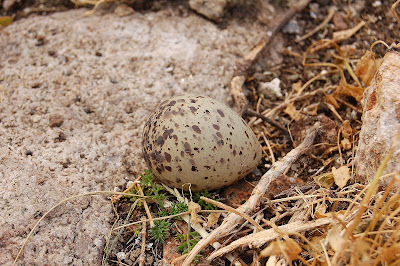"So what do you actually do
out there?" - Like I said before, this is one of the most common questions
we get about working on Rockabill- the term "warden" can seem a bit
vague! At the start of the season it was all about habitat management and
getting the island ready to host as many nesting Terns as possible. Since the
first eggs were laid we've been doing twice-daily nest-checks of a number of
sub-sections of the island. We'll be checking these every morning and evening
between now and when we leave at the end of the summer, so we'll know every
little detail about the timing and number of eggs laid, the hatching success
and growth of the chicks, and ultimately whether those chicks fledged and the
nests were successful.
 |
| At this part of the season we check our study areas for new eggs, twice a day - some are in nestboxes, others outside them. |
Spending a couple of hours each
day checking nests of thousands of Tern species, you see a lot of eggs!!
(understatement alert!) This period is arguably less interesting/fun than when
we have chicks running around the place, but the eggs are interesting too.
Common Terns lay eggs on patches of bare ground, and so their eggs follow the
same basic pattern of most ground-nesting birds eggs - they're coloured to
match the ground as closely as possible, with a series of spots, streaks and
blotches that help break up the outline of the egg against the ground - so any
aerial predators (Gulls, Crows) will have difficulty seeing them and hopefully
pass them by. If you take a plain coloured/patterned chicken egg and put it on
bare soil, gravel or shingle, you'd have no trouble seeing it from a distance,
and knowing that it was an egg too. The Common Tern eggs you'll see below are
usually much harder to spot until you're right up next to them.
In a colony like this where you
have >2,000 pairs of Commons nesting there's considerable variation in
colour and pattern style of eggs. Commons out here nest on bare rock, soil, on
top of vegetation, on top of dead vegetation etc. - all of which are different
colours, and so the population here needs to be able to cope with that.
Essentially, it's a numbers game, as evolution so often is! There's huge
variety in both the eggs they lay, and the substrate they lay on, so there'll
never be a year where all of the eggs are easily found by predators - at least
some (usually most) will successfully last long enough to hatch chicks, who
themselves are well camouflaged too. A good proportion of chicks survive, and
come back in future years to breed, they lay a large number of eggs with
various camouflaged patterns, and the cycle continues!













No comments:
Post a Comment